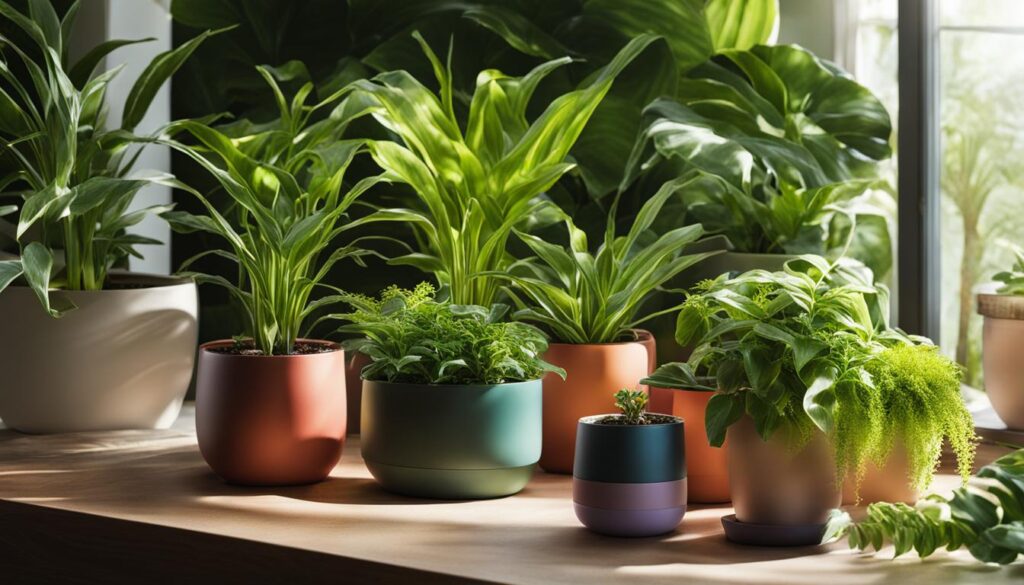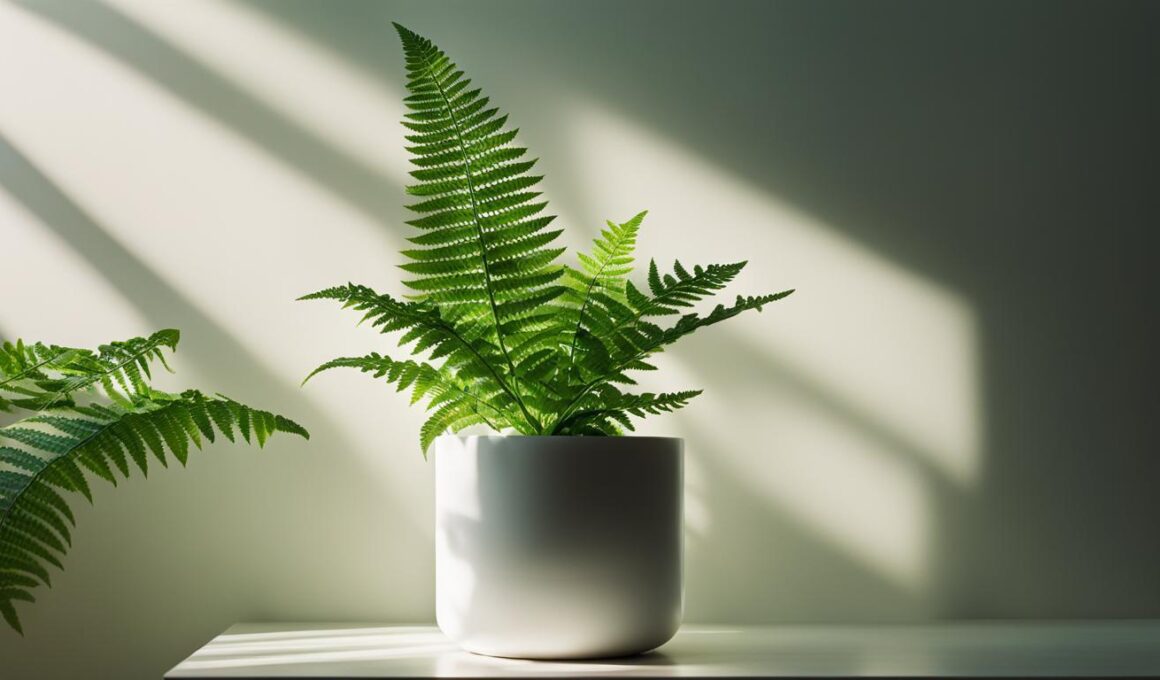Houseplants have a significant impact on our indoor spaces, improving indoor air quality and contributing to our overall health and well-being. These green companions engage in photosynthesis, releasing oxygen and absorbing carbon dioxide, making them natural partners for humans. Certain plants, such as orchids, succulents, and bromeliads, even release oxygen at night, making them ideal for refreshing the air in bedrooms.
Post Summary:- Houseplants improve indoor air quality and contribute to our health and well-being.
- They release oxygen and absorb carbon dioxide through photosynthesis.
- Some houseplants, like orchids, succulents, and bromeliads, release oxygen at night.
- Houseplants can refresh the air in bedrooms and create a more comfortable living space.
- Adding houseplants to our indoor spaces can have a positive impact on our physical and mental well-being.
The Air-Purifying Power of Houseplants
Research conducted by NASA has shown that houseplants have the ability to remove up to 87% of volatile organic compounds (VOCs) from the air within 24 hours. VOCs are harmful substances found in everyday items such as rugs, vinyl, cigarettes, and grocery bags. Plants act as natural air purifiers, pulling these contaminants into the soil where microorganisms convert them into food for the plant. This purifying effect helps improve the overall air quality in our homes and reduces the potential health risks associated with VOC exposure.
“Houseplants act as natural air filters, absorbing harmful toxins and releasing clean oxygen,” says Dr. Sarah Johnson, a botanist at NASA.
“Indoor air pollution is a major concern, as we spend most of our time indoors. By incorporating indoor plants into our living spaces, we can significantly reduce the presence of harmful VOCs and create a healthier environment.”
Not only do houseplants purify the air, but they also enhance the aesthetic appeal of indoor spaces. With a wide variety of indoor plants to choose from, you can easily find one that suits your style and preference. From small succulents to lush tropical plants, there’s something for everyone. Whether you place them on a windowsill, shelf, or in hanging planters, indoor plants can transform any room into a calming and refreshing oasis.
| Plant | Air-Purifying Capability |
|---|---|
| Snake Plant | Filters benzene, formaldehyde, trichloroethylene, xylene, and toluene |
| Spider Plant | Reduces formaldehyde and xylene levels |
| Peace Lily | Removes benzene, formaldehyde, trichloroethylene, and ammonia |
| English Ivy | Filters benzene, formaldehyde, xylene, and toluene |
Adding indoor plants to your home not only improves air quality but also promotes a healthier and more enjoyable living environment. So, go ahead and bring some greenery into your home and breathe in the benefits!

A Breath of Fresh Air – Increased Humidity
Houseplants not only purify the air but also have the ability to increase humidity levels in indoor environments. Through a process called transpiration, plants release moisture vapor into the air, creating a more comfortable and healthier living space. The release of moisture is particularly beneficial in dry indoor environments, such as during the winter months when heating systems can cause the air to become dry and uncomfortable.
Studies have shown that the increased humidity provided by houseplants can have positive effects on our respiratory health. Dry air can lead to respiratory distresses such as dry skin, colds, sore throats, and dry coughs. By increasing the humidity, plants help alleviate these symptoms and create a more soothing environment for our respiratory systems.
“The presence of indoor plants can reduce the incidence of dry skin, colds, sore throats, and dry coughs caused by dry indoor air.” – Indoor Air Quality Researcher
Grouping plants together can maximize the humidifying effect, as the combined transpiration of multiple plants can significantly increase the moisture levels in the surrounding air. This is particularly beneficial in areas with low humidity or during winter when central heating systems are in use.
| Plant | Average Moisture Released (ml/day) |
|---|---|
| Spider Plant | 20 |
| Pothos | 15 |
| Peace Lily | 10 |
| Areca Palm | 25 |
By incorporating houseplants that release moisture vapor into our indoor spaces, we can create a more balanced and comfortable atmosphere while improving our overall respiratory health.

The Health Benefits of Houseplants
Houseplants have been found to have numerous health benefits. Research has shown that the presence of plants in hospital rooms can lead to faster recovery rates for patients, as well as reduced anxiety and fatigue. In office settings, having plants around has been associated with decreased sickness rates, improved focus, and increased productivity. Even in classrooms, students have demonstrated greater attentiveness and attendance when surrounded by plants.
The positive effects of houseplants on health are not limited to specific environments. They can be beneficial in any indoor space, whether it’s your home, workplace, or educational institution. The natural greenery and connection to nature that plants provide can help reduce stress and promote a sense of well-being.
“Plants are not only beautiful to look at, but they also have a profound impact on our physical and mental well-being.”
So, how exactly do houseplants contribute to these health benefits? One theory is that they improve indoor air quality by acting as natural air purifiers. By removing harmful substances from the air, such as volatile organic compounds (VOCs), plants help create a cleaner and healthier environment. Additionally, houseplants release moisture vapor through transpiration, increasing the humidity in the air and reducing the risk of respiratory distresses in dry indoor spaces.
The Impact of Houseplants in Hospitals and Offices
To further understand the health benefits of houseplants, let’s take a closer look at their impact in hospitals and offices:
| Hospital | Office |
|---|---|
| Higher recovery rates for patients | Decreased sickness rates |
| Reduced anxiety and fatigue | Improved focus and productivity |
| Less need for pain medication | Enhanced well-being and morale |
These findings highlight the significant impact that houseplants can have on our physical and mental well-being. Incorporating them into our indoor spaces is a simple and effective way to create a healthier and more enjoyable environment for ourselves.
How Many Plants Do You Need?
When it comes to improving your health, optimizing air purification, and achieving the perfect balance of oxygen levels in your home, the number of plants you need can vary. To make the most of the benefits that plants provide, it’s important to consider plant recommendations based on the desired outcome.
Improving Health and Reducing Fatigue
If you’re looking to improve your health and reduce fatigue, the recommendation is to have one large plant (8-inch diameter pot or larger) for every 129 square feet of space. These larger plants have a greater capacity to release oxygen and create a refreshing atmosphere, helping to rejuvenate your mind and body.
Optimizing Air Purification
To optimize air purification and ensure that your indoor air quality is top-notch, you’ll want to have 15-18 plants in 6-8-inch diameter pots for an 1,800-square-foot house. It’s important to distribute these plants strategically throughout your home, with at least one plant every 100 square feet. This will ensure that the air in every corner of your house is being effectively purified, removing harmful volatile organic compounds (VOCs) and enhancing the overall well-being of your household.
It’s worth noting that the success of your plant selection depends on providing the specific growing conditions required by each plant. While these recommendations provide a general guideline, it’s important to research the needs of each plant and ensure that they are met for optimal growth and benefits.
| Desired Outcome | Number of Plants | Pot Diameter | Total Square Footage |
|---|---|---|---|
| Improved Health and Reduced Fatigue | 1 large plant | 8-inch diameter pot or larger | 129 square feet |
| Optimized Air Purification | 15-18 plants | 6-8-inch diameter pots | 1,800 square feet |
By following these plant recommendations, you can improve the overall health of your indoor environment, enhance air purification, and optimize oxygen levels. Incorporating plants into your home not only adds a touch of natural beauty but also promotes a healthier and more refreshing living space for you and your loved ones.
Do Dead Leaves Provide Nutrients to Houseplants?
Dead leaves and plant growth go hand in hand. As leaves decompose, they release valuable nutrients back into the soil, enriching it for houseplants. This natural process is known as leaf litter decomposition, and it plays a vital role in providing essential elements for the growth and health of your indoor greenery.
Conclusion
While houseplants may not significantly increase oxygen levels in your home, their impact on air quality and health benefits are undeniable. Houseplants actively purify the air by removing harmful volatile organic compounds (VOCs), improving the overall indoor air quality. They also release moisture vapor, increasing humidity and creating a more comfortable living environment.
Furthermore, incorporating houseplants into your indoor spaces can have numerous health benefits. Research has shown that patients in hospital rooms with plants experience faster recovery rates and reduced anxiety and fatigue. In office settings, the presence of plants has been associated with decreased sickness rates and improved focus. Even in classrooms, students demonstrate greater attentiveness and attendance in the presence of plants.
So, don’t hesitate to introduce some greenery into your home. Houseplants may not be the main source of oxygen, but they play a vital role in purifying the air, increasing humidity, and providing various health benefits. By improving air quality and promoting well-being, houseplants can create a healthier and more enjoyable living environment for you and your family.
FAQ
Do houseplants give off oxygen?
Yes, houseplants engage in photosynthesis, releasing oxygen and absorbing carbon dioxide, making them natural partners for humans.
What is the air-purifying power of houseplants?
Houseplants have the ability to remove up to 87% of volatile organic compounds (VOCs) from the air within 24 hours, acting as natural air purifiers. VOCs are harmful substances found in everyday items such as rugs, vinyl, cigarettes, and grocery bags.
How do houseplants increase humidity?
Houseplants release moisture vapor through transpiration, increasing the humidity of the air around them. This can be particularly beneficial in dry indoor environments, such as during the winter months.
What are the health benefits of houseplants?
Houseplants have been found to improve recovery rates in hospitals, reduce anxiety and fatigue, decrease sickness rates in offices, improve focus and productivity, and increase attentiveness and attendance in classrooms.
How many plants do I need?
The number of plants recommended in a space depends on the desired outcome. For improved health and reduced fatigue, one large plant is recommended for every 129 square feet. To optimize air purification, 15-18 plants in 6-8-inch diameter pots are suggested for an 1,800-square-foot house, with at least one plant every 100 square feet.
What is the conclusion?
Houseplants actively purify the air, increase humidity, and provide numerous health benefits. Incorporating houseplants into indoor spaces can improve air quality, promote well-being, and create a healthier and more enjoyable living environment.









